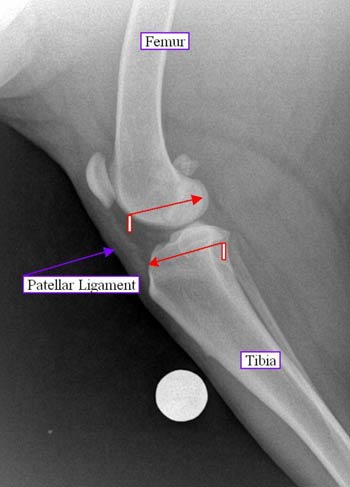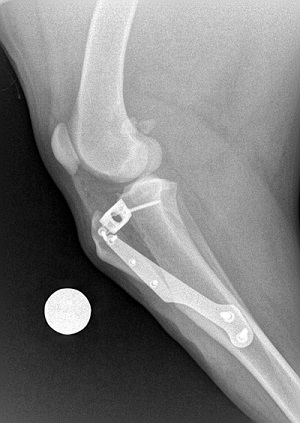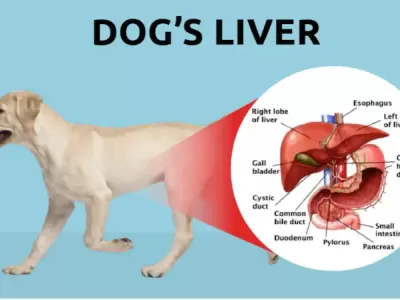Tibial Tuberosity Advancement (TTA)
The Newest Treatment for Canine ACL Rupture. Rupture of the Anterior Cruciate Ligament (ACL) in the knee (stifle) is the most common Orthopaedic Injury in the dog.
The ACL is a major stabilising ligament in the stifle, rupture results in instability between the femur and the tibia, leading to inflammation, and damage to the cartilage and menisci and ultimately osteoarthritis (OA).
TTA is a surgical procedure specifically developed to treat injuries of the ACL in the stifle of the dog.
 How does the TTA work?
How does the TTA work?
During weight bearing, the femur slides down the tibial plateau caudally. The Anterior Cruciate Ligament (ACL) acts against this downward force. Dogs having a steeper slope are more predisposed to rupturing the ACL. A more perpendicular angle between the tibial plateau and the patellar tendon will result in a more stable joint. The TTA aims to correct for this slope by adjusting the angle between the tibial plateau and the patellar ligament. The surgery changes the biomechanics of the stifle joint (redirecting the strong muscular forces of the muscles on the front of the thigh) so that stability is created without applying an artificial physical restraint across the joint. This technique offers more advantages than other surgical techniques by being less invasive and faster to perform. The patients undergoing this procedure do not need to wear any form of bandage when going home. By advancing the tibial tuberosity in an ACL deficient knee, the patellar ligament is adjusted perpendicular to the tibial plateau. This eliminates the tendency of the femur to move downward over the sloped plateau.
The surgical technique involves cutting (osteotomizing) the tibial tuberosity with a special saw and advancing it using a titanium cage. This cage is secured by titanium screws and acts as a bone expander. To achieve final stability a titanium plate is secured to the tibial tuberosity and the tibial shaft by titanium screws. Bone will grow in and slowly fill in the gap providing even more stability over time.

Questions:
Q: Does my dog really need to have surgery? Can I just restrict its movement and use pain medication?
A: Our goal is to return your Dog’s knee to the same level of function it had prior to the injury. Currently the only option to achieve complete return to near normal is surgery. Alternative methods of treatment are available that can help the patient to cope with pain and long term inflammation, suffered when the knee becomes unstable after the ligament has been damaged. However surgery offers the best outcome in limiting the development of progressive debilitating osteoarthritis. Once the joint starts to develop arthritis, the prognosis for repair and return to normal is poor.
Q: My friend told me that their dog had the same problem and after a while it was able to walk again without a limp.
A: After approximately 1 year following the injury the knee joint capsule and the tissue surrounding the joint will suffer from excessive fibrosis in an attempt by the body to stabilise the joint. Extra scar tissue will form in response to the chronic inflammation of the joint (arthritis). The mobility of the knee will be affected and your pet will be able to walk, but generally with a severe limp and will not be able to run, jump or play as before the injury. Unfortunately these patients gain weight due to inactivity and eventually injure the opposite knee a few months to years later.
Q: How much pain is my pet going to experience in the post operative period?
A: Our aim is for your pet to have the ultimate degree of pain relief, there are new drugs out now, which we use in combination, to achieve excellent pain relief, and we also perform an epidural, which assists in making your pet comfortable. Following surgery your pet will be sent home with pain medication, as well as antibiotics to help prevent infection. Weekly revisits are undertaken which enable us to assess the progress post surgery.
Q: When will my pet start to walk again?
A: Normally your pet will just be placing the leg down within a few days (toe tapping); weight bearing will generally begin to start within a week of surgery. Q: Are the other surgical procedures available? A: There is a procedure similar to a TTA called a TPLO (tibial plateau levelling osteotomy) which also aims to adjust the angle of the tibial plateau, it is more invasive, requires more patient confinement and a longer recovery. There are cases where the TTA is not recommended and the TPLO is the only acceptable technique. Each TTA procedure is individually planned for each dog’s size and bone shape and procedure specific implants are used. There are also other surgical techniques, such a the LigaFiba Isotoggle which are more applicable to smaller dogs, such as less than 20kg body weight, they can give an acceptable result as long as the post operative period is managed well.
Q: Is the post operative period more painful compared to other procedures like a TPLO?
A: It is less painful, as the TTA is performed on a non-weight bearing portion of the bone; all patients are amazingly comfortable in a short period of time.
Q: How long does it take for my pet to be back to normal activity?
A: The osteotomy takes 6-8 weeks to heal. The recovery is related to the length of time between injury to the ACL and the surgery. Muscle atrophy associated with loss of function on the affected knee may lead to a longer recovery time if surgery is delayed for an extended period of time. The majority of dogs are back to near normal, within 6 months.
Q: Will my dog injure the other knee in the future?
A: Up to 30 to 40% of dogs with ACL rupture in one knee will experience the same problem in the opposite knee. The best way to decrease the percentage is to perform the TTA as soon as possible to avoid, so as allowing a quicker recovery as well as managing activity post surgery.



